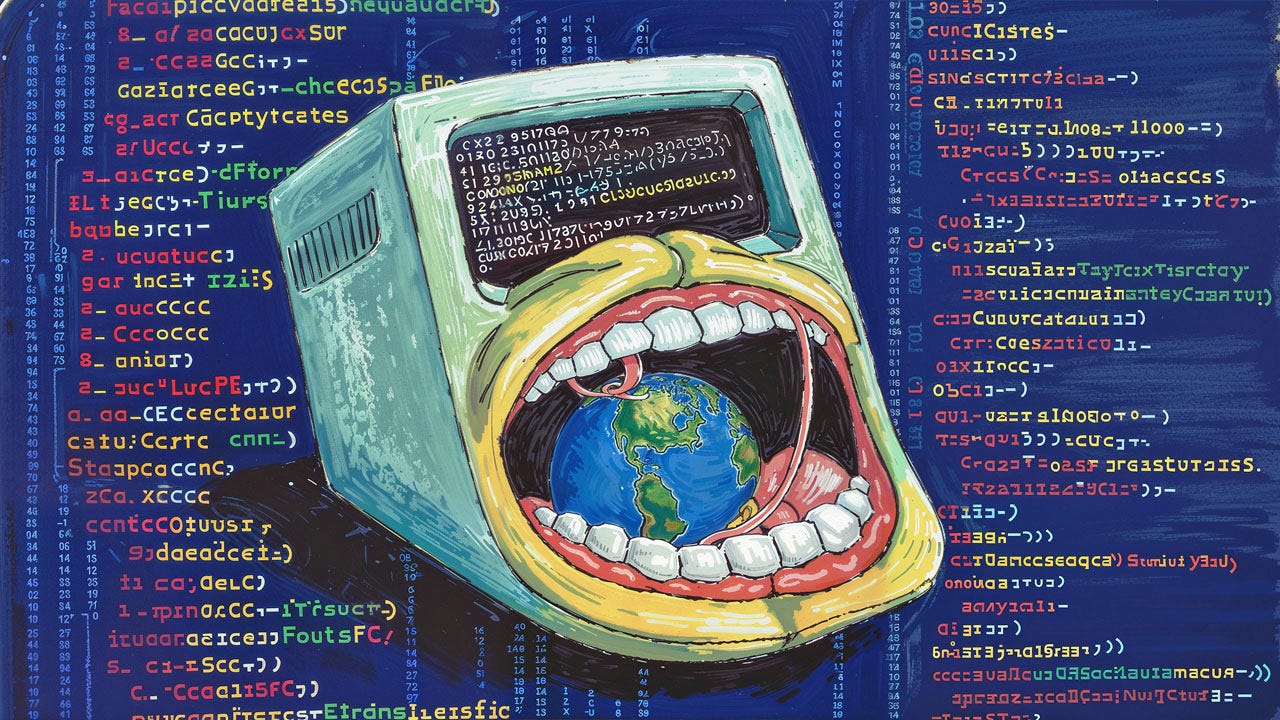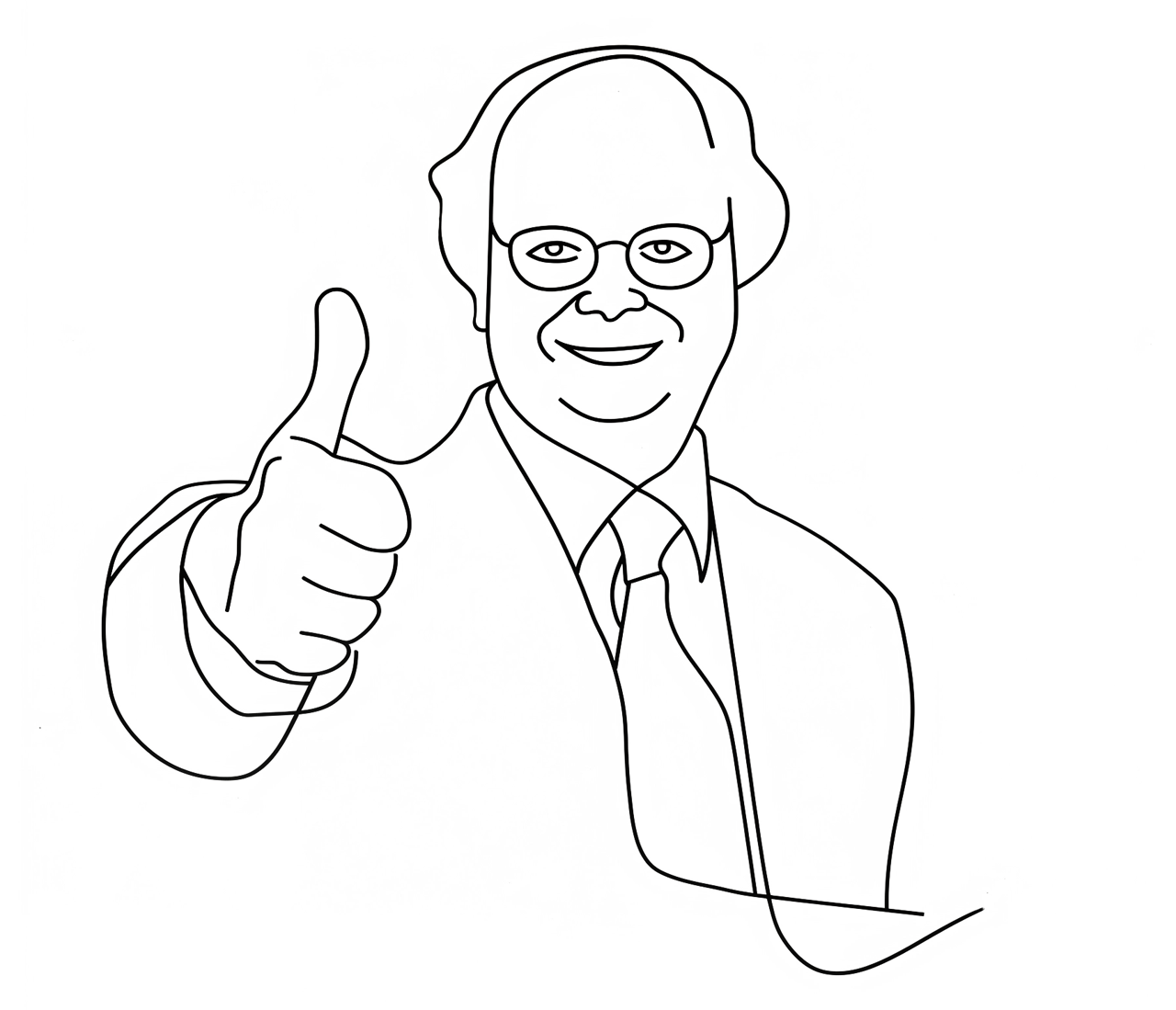Peak Programmer ≠ Peak UX
Summary: The Evolution Awaits: In a decade, AI will transform our productivity landscapes, tripling UX outputs and decimating developer teams. The shift promises a radical restructuring of tech roles, prioritizing cognitive leverage over traditional staffing.
This may be the year of Peak Programmer, by which I mean the year with the most people employed as professional software developers. There were fewer programmers in the past, and there may be fewer programmers again in the future. The growth of programming as a profession was caused by the trend of “software is eating the world,” as Marc Andreessen pronounced. He was right, and it’ll keep eating, but with less staff.
In 2011, Marc Andreessen said that “software is eating the world,” and he has been right for 13 years. The next decade will be “user experience is eating the world,” so we’ll need fewer programmers and more UX professionals. (Ideogram)
We know from many controlled studies that AI improves the productivity of all knowledge workers, with an estimated task-level performance improvement of 40% for mainstream business professionals (and probably also for UX professionals, though their performance has not been measured in formal, controlled experiments).
However, the AI-improvement factor for software developers is about 3 times as high as that for other business professionals, at around 120%.
Why Programmers Benefit Disproportionally from AI
Why do programmers gain 3x the benefits of other knowledge workers? I would like to see more in-depth research on this question, but for now, I have three plausible explanations:
First, programming is the most cognitively-demanding work known to humanity. I hesitate to admit this, but you need a much higher IQ to be a good programmer than to be a good UX designer. Programmers need to keep a huge number of chunks of information in their short-term memory and also have a strong mental map of the entirety of the software they’re developing. AI is a forklift for the mind: it helps everybody by lifting heavy cognitive burdens, but it probably helps the people the most who are weighted down the most by their cognitive load.
AI is a forklift for the mind: it takes over some cognitive load for users, allowing them to “lift” more. (Midjourney)
The usual conclusion from this assumption is that AI narrows skill gaps by helping weak performers more than it helps strong performers. (In other words, within the same profession, staff with lower IQ or less experience gain more from AI than do staff with higher IQ or more experience.) This narrowing of skill gaps has been proven in countless studies by now, so we can accept it as a fact, even if the exact mechanism by which AI helps poorer performers more than strong performers hasn’t been fully determined yet.
It's possible that there is a second conclusion from my hypothesis that AI helps the most when people are cognitively overtaxed. It’s not just stupid people who are helped, but also smart people who juggle incredibly difficult cognitive tasks. In other words, it’s not IQ as such, in terms of the absolute number, that matters. It’s the mismatch between the user’s IQ and the user’s task. As a simplified example, consider these 3 scenarios:
IQ 115 employee performing a task that is medium-demanding of cognitive resources, such as UX design. Hard work.
IQ 130 employee performing that same, medium-demanding task. Easy work.
IQ 130 employee performing a task that is highly-demanding of cognitive resources, such as software development. Hard work.
My hypothesis is that AI will help the first and last employees the most, because of the bigger gap between their cognitive capacity and the demand of their task. The middle employee will also be helped by AI, but not by as much because his or her cognitive capacity is not that heavily taxed by the task.
Three warehouse workers: a weak and a strong worker carrying midsized boxes, and a strong worker carrying twice the load. If the warehouse gets forklifts, the left and the right workers will be helped more than the middle worker. (Ideogram)
The second explanation for why AI helps programmers more than other knowledge workers is simpler: AI may be particularly useful for software development because most current AI is based on large language models, and programming is a language-manipulation task. (Using a programming language, instead of natural language, but that difference may turn out to be less important than we might have thought.)
A third explanation is that programmers are geeks, so they are better suited to using current AI tools that are poorly usable.
I believe all three explanations are correct: all contribute to causing that 3x advantage for the programmers. (More research will be needed to estimate the relative contribution from each of these three factors.)
AI Productivity in 10 Years
The estimates that AI increases task performance by 40% for most knowledge workers and by 120% for programmers are from research conducted with GPT-4 class foundation models. This primitive level of AI will soon be relegated to the dustbin of history. What about future AI? Let’s look a decade ahead.
I predict that the effect of AI in 10 years will be as follows:
3x productivity for knowledge workers in general, including user experience.
10x productivity for software development.
I don’t predict that AI will account for these big improvements in itself. Rather, AI will probably cause UX staff to be 2x as productive and developers to be 4x as productive on an individual basis. However, all major products are built by teams. The larger the team, the more ineffective it is. Countless hours are spent on communications overhead and management.
If you have a team of 100 programmers, you need about 12 managers, 3 directors, and one VP. This doesn’t add 16% management overhead, but more like 33%, when you account for managers and executives being much more expensive and also for the need for the worker bees to spend time managing up. Furthermore, bigger organizations allocate progressively more time to internal politics, and after surpassing about 100 people, promotions become more driven by catering to the VP’s whims than by building for customers, totally undermining productivity in terms of shipping something that matters to customers.
Despite these productivity drains on bigger organizations, it’s still not the case that a two-pizza team (the number of people who can share two big pizzas as their only food for lunch) can produce the same as a 100-person department. But the 100 people only produce maybe 5x what 10 people can do. Ever since Fred Brooks wrote The Mythical Man-Month in 1975, we’ve known Brooke’s Law, which states that “adding more people to a software project only makes it more late.” Now, for the first time, we can run Brooke’s Law in reverse and use small teams again.
Will this feed your team for lunch? If so, you have the basis for peak team performance and minimal management overhead. (Midjourney)
If we use AI to cut a product team to 10 programmers, we can probably get by with a single manager. Also, the communication between the developers is dramatically simplified.
That’s why I think a team of 10 AI-augmented developers in 2034 will be able to produce the work of 100 developers in 2023, who didn’t have AI assistance. The very highest productivity will come from projects done by a single person, because communication overhead drops to zero when all project information is contained within a single brain. That’s a major reason for the resurgence in “UX Unicorns” (people who can do all parts of the UX design lifecycle).
Similarly, 5 UX people in 2034 will be able to do the work of 15 UX people in 2023. We don’t get the same gains because AI is still likely to help the individual developers more than it helps individual UX professionals. And because UX staffing has tended to be much less generous than development staffing, there’s also less management layers to eliminate. Even so, across an entire corporation (as opposed to the individual product teams), bigger companies will be able to eliminate most of their UX Directors and VPs, and they will certainly be able to save most or all of super-expensive UX SVPs. This flattening of the organization is part of what I call the future pancaking of the UX field.
The pancaking of the UX field implies a thinner hierarchy, but broader coverage. As AI improves future productivity even more, team sizes can shrink, leading to the elimination of even more management layers, for more of a UX crepe. (Midjourney)
We’re already seeing some companies prepare for this future, in downgrading their valuation of UX senior management levels. As of early 2024, salaries for higher-level UX leaders seem to have dropped by about 20% compared with the pre-AI boom year of 2022, which seems reasonable when considering that the supply of such senior talent has boomed in recent years, whereas they may be less needed in the future. Supply and demand determines pricing, also for UX VPs. (In contrast, salaries for non-executive UX staff only dropped by 11%, demonstrating the market’s assessment of the relative supply–demand changes at different levels of the hierarchy as UX pancaking takes off.)
Even though salaries will drop for the most overpriced senior UX staff, there will still be some need for senior staff who are not VPs. In general, I don’t predict unemployment caused by AI. Even if the same work product will only require 1/10 of the programmers and 1/3 of the UX staff, that doesn’t mean that re remaining 9/10 and 2/3, respectively, will be surplus to requirements. Instead, as both programming and user experience become cheaper, more of it will be bought.
There’s an endless need for more software development and UX research and design worldwide. Most of these needs currently go unmet because of a lack of programmers and the high expense of bespoke old-fashioned UX methods.
As our work products become cheaper, more of these needs will be met, and the world will become a better place with technology that better matches human characteristics.
Remember that better UX isn’t just a matter of the researchers discovering a need and the designers figuring out a clever way to meet this need. This design also needs to be built, and the more advanced the design (in terms of having the computer do the work for users), the more software development will be needed.
Peak Programmer = Now
I don’t predict unemployed software developers, but I also don’t predict more of them in the future. I think that right now we have the most software developers we will ever have, at least in rich countries. This is a change from my entire life, where we’ve always suffered an undersupply of programmers. There were never enough young people willing (or able) to undergo the rigors of a computer science education.
10x cheaper software development will likely mean 10x more software being developed, but no more. In the further future, as AI becomes even stronger, the need for programmers may even decline, and the profession will shrink as the oldtimers retire.
However, even though I think that 2024 is the year of Peak Programmer, I don’t think it’s the year of Peak UX. Two reasons:
As mentioned, I don’t predict as great productivity increases for UX as for developers. If 10x as much software is being developed, but UX professionals are only 3x as productive as before, we’ll need about 3x the UX staff to maintain current quality levels.
I expect the requirements for higher UX quality to increase as the world gets richer and as more of it is “eaten by software.” The dominant change is likely to be one of “UX is eating the world,” where experience quality becomes more and more of a differentiator.
With software development costs being 1/10 of before, just having features won’t be a differentiator. Everybody will have all the features in the world. The difference will be whether customers are able to easily use these features and whether they like the experience. Differentiation is where the investment will be.
Future Development Team Composition
The following chart compares the staffing of a typical software development team in the last year before widespread AI assistance (2023) with my prediction for the situation in 10 years (2034). I am estimating the relative number of 3 types of staff, including both individual contributors and management: software developers, UX designers, and user researchers.
My estimate of the relative number of people on a project team last year and in a decade.
Roughly speaking, we used to have 12% of the team devoted to finding out what would be built (2% researchers and 10% designers) and 88% of the team working on actually making this happen (88% developers). Of course, these percentages only apply to companies with a decent level of UX maturity. There are still many companies in the world with either no UX or a laughably small UX effort that can only scratch the surface and prevent the worst usability disasters. In these cases, we can’t say that “UX is determining what should be built.” They just keep the wolf from the door.
(In these estimates, the category of “UX Designers” includes interaction designers, visual designers, information architects, UX writers, sound designers, conversation designers, persuasion designers, and any other specialized form of design.)
A growing share of companies now have decent UX efforts, and I certainly expect this share to grow in the future as UX becomes cheaper (and thus easier to afford) and development becomes much cheaper (thus freeing up the budget). My chart doesn’t account for more companies doing UX. I’m predicting what will happen in a company with decent UX maturity.
As you can see, I predict that the overall project budget will be cut in half. (To repeat myself, this won’t cause unemployment, because more than twice as many projects will be started.) In fact, the number of programmers will be cut to less than 1/4 of current numbers, but because they’ll be 10x as productive, the project will be able to ship more sophisticated software.
My prediction is that as it becomes ever-cheaper to make software happen, it will become ever-more important to decide what to build. I think we will have 5x the user researchers and twice the UX designers compared to now. And since they’ll be about 3x as productive, thanks to future AI, the amount of research insights and design polish will explode.
Do we need this UX explosion? Yes, we do. Computers are still unacceptably hard to use, especially for people with less technical sophistication and low literacy skills. I have often complained about the articulation barrier in prompting current AI tools, even when used by highly educated, highly-literate users like you and me. Low-literacy users, who can barely write a coherent sentence? Forget it.
There will be a UX explosion. And we need it! (Ideogram)
Future of UX Consulting
The exploding efficiency of small in-house UX teams will be the death of traditional UX consulting firms. We all know how consulting works: you have one top-tier expert who represents the firm to the world and is a recognized thought leader. The figurehead is supplemented by a few tier-2 people who run the company, and as many tier-3 people as the traffic will bear to deliver actual client services. Everybody knows this, including the clients who know they won’t hear from the top guy after signing the contract.
Clients go along with this time-honored consulting practice because they don’t have sufficient in-house expertise to do the job. But in the future, companies formerly known as “clients” will turn into “UX-doers” without a need for “design thinking” courses. They don’t need to be hectored on how to think, because they’re already doing exactly what works in their industry with staff who are double experts, knowing both established UX best practices and how to apply them to the domain-specific designs in that company.
Former top agency IDEO has already been cut in half, and a harsher fate awaits other UX consulting firms as AI accelerates the changing market. (It would have changed anyway due to the commodification and pancakeing of UX, but not at nearly the speed I expect now.)
AI changes both the products being designed and the workflow of the teams that ship those products. These revolutionary changes mean that the UX world will look completely different in 10 years, invalidating most of the experience of currently-senior folks unless they go back to basics and get hands-on experience working in an AI-enabled team that ships AI-enabled products. Being divorced from product development worked for UX consultants in the past because they could rely on their old experience for decades while advising clients operating at low UX maturity levels.
10 years from now, digital products will be completely different, and product teams will be completely different. (Less than half the size, for one.)
As an example, consider my experience working on user interfaces at IBM in 1985 with a potential consulting project I might be doing in 2024. (I don’t consult anymore, but just for the thought experiment.) Most huge corporations work along the same lines as 1980s IBM. Management presentations may be called “PowerPoint presentations” instead of “foils presentations,” but a product manager from back then would quickly adjust to the present day. And even though the mainframe software from 1985 was more primitive than today’s mobile apps, many of the UI design decisions and workflow problems are quite similar. So a UX consultant today could draw upon 39-years old experience and still give good advice, especially if he or she had done other projects in the meantime.
In contrast, senior folks today will likely be completely worthless in 10 years. I include myself in this assessment. If I still write relevant articles in 10 years, it’ll be because of extensive efforts to keep up with the changes. So that’s my advice to any senior UX folks reading this: get out of your comfort zone and start shipping AI-enabled products while working with an AI-enabled product-design team.
I predict a reshaping of the UX consulting business as symbolized by these two camels:
From time immemorial until now, the UX consulting business has been shaped like the Arabian Camel, or Dromedary to the left: with one hump. Most money was to be made in the middle. In our AI-transformed future, traditional UX consulting companies will die and be replaced by a distribution looking like the Mongolian Camel (Bactrian) to the right: with two humps. Some low-end mass-production firms will crank out digital media for small clients, and a small number of 1-to-5-person boutique firms will provide high-end UX strategy consulting to rich clients. The middle will be empty and replaced by efficient in-house teams. (Ideogram)
The big middle, which has been so profitable for many UX consulting firms for the last two decades, will largely vanish. Since standard UX is well-documented, it’ll be much more cost-effective for mid-sized and large companies to have their own UX staff who specialize in their domain.
Small clients will still need help. The local dentist or restaurant won’t build a UX team, but they do need a digital presence so there will continue to be a need for consultants to supply this. These low-end consultants may turn into large suppliers that operate at scale using Generative UI to deliver customized designs to each client at a low cost by applying AI-generated moodboards approved by the client. Similar to the way Midjourney can apply a style to its generative AI production of images, these vendors will create turnkey products with designs that comply with all the UX best practices that people like me worked so hard to discover over the last 40 years. Very low cost, very high volume, more than good-enough quality.
Conversely, on the high end, there will likely be a smaller hump of high-cost, high-end boutique UX consulting firms that deliver luxury consulting services to rich clients. I expect these boutiques to be either one-person shops (so that the client actually gets the figurehead in a service engagement) or a tight team of up to five people, all of whom are figurehead-level experts.
A Quiz to Reinforce Your Understanding of This Article
Here are 10 questions to explore your understanding of this article. The answers are given after the author's biography. To get the full benefit of the quiz, I recommend that you attempt to answer all 10 questions on your own before looking at the answers.
Take the test! (Midjourney)
Question 1: How does this animal metaphorically relate to the expected changes in the UX consulting business?
Question 2: What is the predicted effect of AI on UX productivity over the next decade?
A) Decrease by 30%
B) Increase by 50%
C) Triple
D) Double
Question 3: What metaphor does the article use to describe AI's role for workers?
A) A bridge
B) A ladder
C) A forklift
D) A road
Question 4: According to the article, why might AI particularly benefit programmers?
A) Their work is less demanding
B) They are less intelligent
C) Their tasks involve heavy cognitive loads
D) They have lower productivity
Question 5: How does AI affect team composition in software development, according to the article?
A) Increases the number of managers needed
B) Reduces the overall team size
C) Makes teams more hierarchical
D) Decreases the number of UX designers
Question 6: What analogy is used to describe a team that can operate with minimal management?
A) A sports team
B) A classroom
C) A symphony orchestra
D) A two-pizza team
Question 7: What significant change will AI bring to UX consulting?
A) Increase in large UX consulting firms
B) Shift towards more in-house UX teams
C) Higher demand for UX consulting
D) More international collaboration
Question 8: Why are smaller teams considered more effective in the future, according to the article?
A) They are cheaper to maintain
B) They have fewer communication issues
C) They require less office space
D) They are more motivated
Question 9: What does the future role of AI in teams primarily reduce?
A) Creativity
B) Workload
C) Job opportunities
D) Management layers
Question 10: What is the estimated current task-level performance improvement from AI for mainstream business professionals?
A) 10%
B) 20%
C) 40%
D) 60%
Question 11: What comparison is made to explain the role of AI in team size and productivity?
A) The Mythical Man-Month
B) Moore's Law
C) Newton's Third Law
D) The Pareto Principle
Question 12: Which scenario will benefit the most from AI?
A) A medium-IQ employee doing easy tasks
B) A high-IQ employee doing highly demanding tasks
C) A high-IQ employee doing easy tasks
D) A low-IQ employee doing undemanding tasks
Question 13: How will AI affect the salary structure within the UX profession, according to the article?
A) Increases overall salaries
B) Decreases executive salaries more than non-executive
C) Standardizes salaries across the board
D) Eliminates salary differentiation
Question 14: Which of the following is NOT listed as a reason for AI's greater benefit to programmers?
A) Cognitive demand of programming
B) Programming being a language manipulation task
C) Programmers' general reluctance to adopt new technologies
D) AI tools' poor usability
Question 15: What does the article imply about the future need for UX skills in relation to software features?
A) Increased need as UX becomes a differentiator
B) Less need due to decreased software complexity
C) Decreased need as software becomes self-designing
D) No change as software features remain static
About the Author
Jakob Nielsen, Ph.D., is a usability pioneer with 41 years experience in UX and the Founder of UX Tigers. He founded the discount usability movement for fast and cheap iterative design, including heuristic evaluation and the 10 usability heuristics. He formulated the eponymous Jakob’s Law of the Internet User Experience. Named “the king of usability” by Internet Magazine, “the guru of Web page usability” by The New York Times, and “the next best thing to a true time machine” by USA Today.
Previously, Dr. Nielsen was a Sun Microsystems Distinguished Engineer and a Member of Research Staff at Bell Communications Research, the branch of Bell Labs owned by the Regional Bell Operating Companies. He is the author of 8 books, including the best-selling Designing Web Usability: The Practice of Simplicity (published in 22 languages), the foundational Usability Engineering (26,919 citations in Google Scholar), and the pioneering Hypertext and Hypermedia (published two years before the Web launched).
Dr. Nielsen holds 79 United States patents, mainly on making the Internet easier to use. He received the Lifetime Achievement Award for Human–Computer Interaction Practice from ACM SIGCHI and was named a “Titan of Human Factors” by the Human Factors and Ergonomics Society.
Subscribe to Jakob’s newsletter to get the full text of new articles emailed to you as soon as they are published.
Watch: Jakob Nielsen’s 41 years in UX (8 min. video)
Quiz Answers
Here are the answers to the 10 questions from the end of the article.
Question 1: How does this animal metaphorically relate to the expected changes in the UX consulting business?
Correct answer: The two-humped (Bactrian) camel symbolizes that the expected future UX consulting business will bifurcate, with good business on the low end (creating the digital presence for small clients) and the high end (small boutique UX firms with 1-5 senior experts selling expensive services to rich clients).
Question 2: What is the predicted effect of AI on UX productivity over the next decade?
Correct answer: C) Triple
Question 3: What metaphor does the article use to describe AI's role for workers?
Correct answer: C) A forklift
Question 4: According to the article, why might AI particularly benefit programmers?
Correct answer: C) Their tasks involve heavy cognitive loads
Question 5: How does AI affect team composition in software development, according to the article?
Correct answer: B) Reduces the overall team size
Question 6: What analogy is used to describe a team that can operate with minimal management?
Correct answer: D) A two-pizza team
Question 7: What significant change will AI bring to UX consulting?
Correct answer: B) Shift towards more in-house UX teams
Question 8: Why are smaller teams considered more effective in the future, according to the article?
Correct answer: B) They have fewer communication issues
Question 9: What does the future role of AI in teams primarily reduce?
Correct answer: D) Management layers
Question 10: What is the estimated current task-level performance improvement from AI for mainstream business professionals?
Correct answer: C) 40%
Question 11: What comparison is made to explain the role of AI in team size and productivity?
Correct answer: A) The Mythical Man-Month
Question 12: Which scenario will benefit the most from AI?
Correct answer: B) A high-IQ employee doing highly demanding tasks
Question 13: How will AI affect the salary structure within the UX profession, according to the article?
Correct answer: B) Decreases executive salaries more than non-executive
Question 14: Which of the following is NOT listed as a reason for AI's greater benefit to programmers?
Correct answer: C) Programmers' general reluctance to adopt new technologies
Question 15: What does the article imply about the future need for UX skills in relation to software features?
Correct answer: A) Increased need as UX becomes a differentiator













I see how quizzes can be a playful way to check understanding here in the newsletter, but I hope they won't be overused as the primary form of assessment later on in school.😂